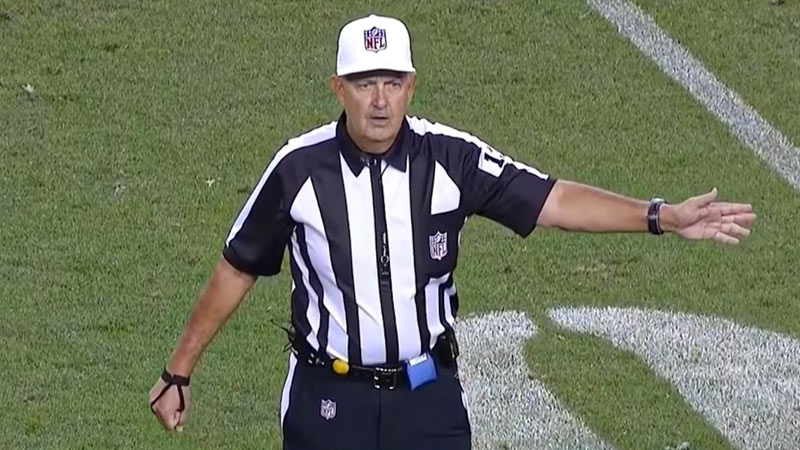In the electrifying world of American football, precision, strategy, and order are essential to the game’s success. Central to this dynamic is the often unsung hero of the field, the referee.
The movements of the American football referee position are carefully choreographed, ensuring that every play unfolds with fairness and safety.
As we delve into this blog post, we’ll uncover the vital role the referee position plays in maintaining the integrity of the game.
From the referee’s position in the offensive backfield to their eagle-eyed focus on the quarterback, their decisions keep the game’s pulse steady.
We’ll explore how they enforce penalties, blow the whistle, and meticulously manage the game and play clocks while maintaining an unwavering commitment to player safety and the sport’s rules.
Join us in dissecting the core of American football officiating, where the referee’s positioning is the linchpin of the entire gridiron operation. So, stay sharp.
The Basics of American Football Refereeing
American football refereeing is a crucial aspect of the game, ensuring fair play and safety. Referees are responsible for enforcing the rules, making judgment calls, and maintaining order on the field.
Key officials include the head referee, who oversees the game, and other officials like umpires, linesmen, and back judges. The head referee signals the start of play, monitors the game clock, and announces penalties.
Umpires focus on the line of scrimmage, ensuring fair play among the offensive and defensive lines. Linesmen and back judges watch for offside, pass interference and other infractions.
They use signals like hand gestures and penalty flags to communicate decisions.
American football officiating requires deep rulebook knowledge, quick decision-making, and good communication skills. It’s essential for maintaining the integrity of the game and ensuring player safety.
Role of The Head Referee
The head referee in American football plays a central role in officiating the game. Their responsibilities include:
Coin Toss
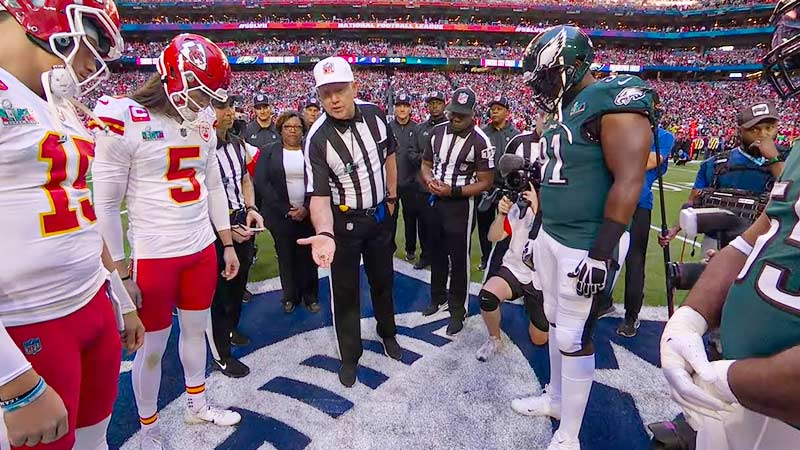
The head referee conducts the coin toss before the game to determine which team gets the initial possession and choice of ends.
Game Clock Management
They are responsible for monitoring and controlling the game clock, ensuring it runs properly, and signaling the start and stop of the clock for various game situations.
Enforcing Rules
The head referee enforces the game’s rules, ensuring fair play and penalizing infractions such as fouls, offsides, and false starts. They announce penalties and assess yardage as necessary.
Judgment Calls
The head referee makes crucial judgment calls on plays, including whether a pass was complete or incomplete, whether a player was in or out of bounds, and whether a fumble occurred.
Scoring Decisions
They confirm and announce when a touchdown or field goal is scored and signal for extra or two-point conversion attempts.
Challenges and Reviews
In games with replay review systems, the head referee communicates with the replay officials and announces the results of reviewed plays.
Game Administration
They manage game-related administrative tasks, such as timeouts, challenges, and substitutions.
Communication
The head referee communicates decisions to players, coaches, and the audience using hand signals and a microphone, ensuring transparency and understanding.
Player Safety
Ensuring player safety is paramount. The head referee can stop the game if they believe a player’s safety is at risk and can take actions such as ejecting players for flagrant fouls.
The head referee’s role is vital in maintaining the integrity of the game, upholding the rules, and ensuring a fair and safe playing environment for all participants.
On-the-Field Mechanics of the Referee
The on-the-field mechanics of the referee in American football involve specific positioning and actions to officiate the game effectively. Here are some key points:
Positioning
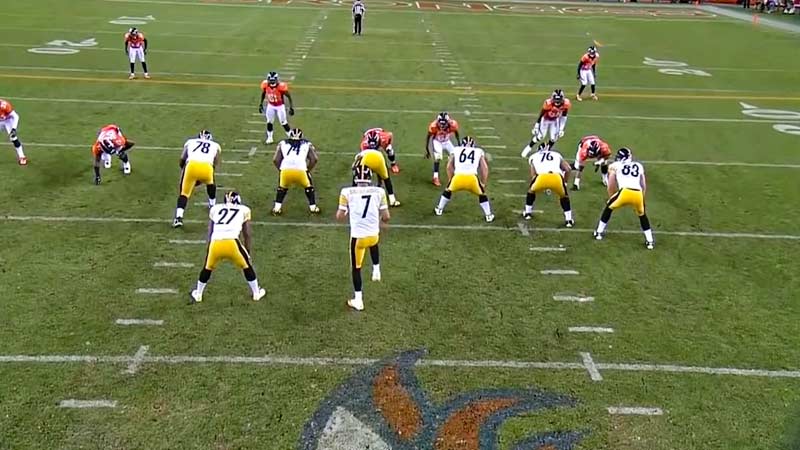
The referee’s primary position is in the offensive backfield, typically a few yards behind the quarterback, known as the “Referee’s Position.”
This location provides a clear view of the action while staying safe from collisions.
Coin Toss
Before the game, the referee conducts the coin toss at midfield, with captains from both teams and a designated coin toss official.
Pre-Snap
The referee observes the offensive and defensive line of scrimmage, ensuring players are properly aligned and there are no encroachments. They also monitor eligible receivers and potential ineligible players downfield.
Play Start
At the snap, the referee watches the quarterback, the football, and the offensive backfield. They determine whether the ball is passed, handed off, or if a play-action fake is executed.
Penalty Enforcement
When penalties occur, the referee announces them to the teams and signals the nature of the infraction. They also mark off the yardage and coordinate with other officials to ensure accurate enforcement.
Incomplete Pass and Forward Progress
The referee makes judgment calls on incomplete passes, forward progress, and whether a player is down by contact. They blow the whistle to signal the end of a play when a ball carrier’s forward progress is stopped.
Dead Ball Situations
The referee signals the end of each play, whether due to a touchdown, incomplete pass, player out of bounds, or other circumstances.
They also restart the play clock and game clock as needed, ensuring the game’s smooth flow.
The referee’s on-field mechanics are essential for maintaining order, enforcing rules, and keeping the game safe and fair.
They must move efficiently, communicate clearly, and make quick decisions to facilitate the game’s progress.
American Football Referee Position
In American football, the referee position is one of several roles officials hold on the field. The referee has specific responsibilities and positioning, which include:
The Backfield Position
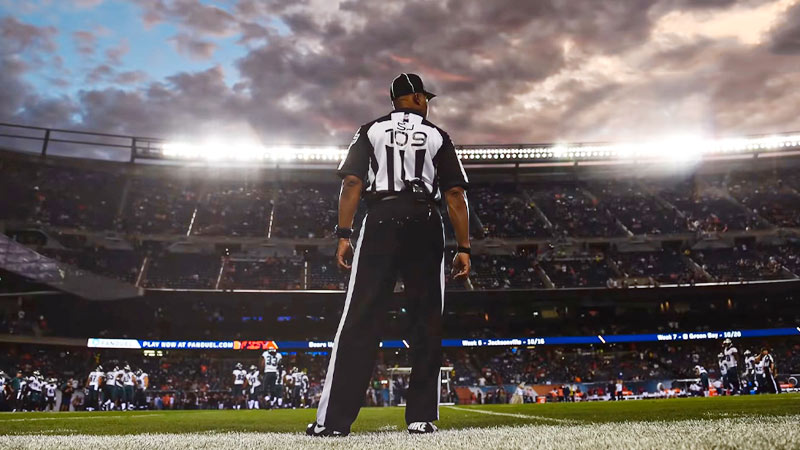
The referee typically stands in the offensive backfield, a few yards behind the quarterback, directly behind, and to the right (or left) of the quarterback’s throwing arm.
This location provides a clear view of the quarterback, the football, and the entire backfield. It allows them to monitor the action, watch for potential fouls, and ensure the safety of players.
Observing the Snap
The referee’s primary duty is to oversee the snap of the football, ensuring that it is executed properly and fairly. They watch for any false starts, encroachments, or other infractions that may occur during the snap.
Monitoring Quarterback
The referee closely watches the quarterback, especially during passing plays, to determine if a forward pass or a handoff is made.
They need to make quick decisions regarding incomplete passes, forward progress, and roughing-the-passer fouls.
Penalty Enforcement
When penalties occur, the referee announces and signals the nature of the infraction.
They are responsible for marking off the appropriate yardage, providing necessary information to the teams, and coordinating with other officials for penalty enforcement.
Blowing the Whistle
The referee uses a whistle to signal the start and end of each play. This includes blowing the whistle when the ball carrier’s forward progress stops or a player steps out of bounds.
Game and Play Clock Management
The referee manages the game clock and the play clock, ensuring they are started and stopped at the right moments, especially during timeouts, delays, or other game stoppages.
Safety and Fair Play
Referees are responsible for the overall safety of the players, and they have the authority to stop the game if they believe a player’s safety is at risk.
They can also eject players for flagrant fouls or unsportsmanlike conduct.
The referee position in American football is critical for overseeing the game’s flow, enforcing the rules, and ensuring a fair and safe playing environment for all participants.
Referee’s Decision-Making and Video Review
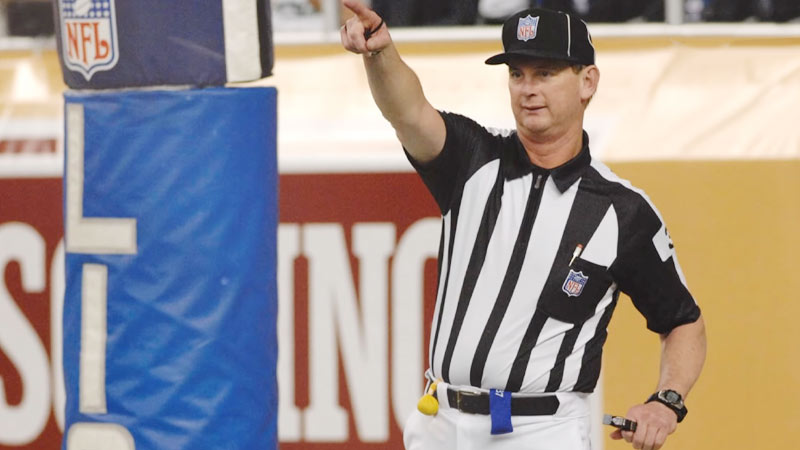
In American football, the referee’s decision-making process is crucial to maintaining the integrity of the game.
Video review, also known as instant replay, can play a significant role in helping referees make accurate calls. Here’s how these two aspects intersect:
On-Field Decision-Making
- Referees make real-time judgments on various aspects of the game, including ball possession, touchdowns, incomplete passes, player down by contact, and more.
- Their decisions are based on their perspective and observations from their positions on the field.
- Referees use hand signals and verbal communication to convey their decisions to players, coaches, and the audience.
Challenges and Reviews
- Video review allows for certain calls to be challenged and reviewed by coaches or initiated by officials in specific situations.
- Coaches are typically allowed a limited number of challenges per game to question specific on-field decisions.
- In some cases, officials themselves can trigger a review, particularly in the final two minutes of each half when most reviews are initiated by the booth.
- A replay official or a designated replay booth assistant reviews available camera angles to determine if the call on the field should be upheld, overturned, or confirmed.
Reviewable Calls
- Common reviewable calls include scoring plays (e.g., touchdowns and field goals), boundary line decisions (e.g., whether a player was in or out of bounds), and turnovers.
- Reviewable calls often focus on factual determinations instead of judgment calls made by the officials.
Overturning Decisions
- For a call to be overturned, there must be clear and convincing evidence that the original call was incorrect.
- The replay official or booth assistant communicates with the head referee to convey the decision, and the referee announces the outcome to the teams and the audience.
Maintaining Game Flow
Video review is used to ensure fairness and accuracy but is not intended to disrupt the flow of the game significantly. The process is designed to be efficient, with a time limit for reviews.
Influence on Refereeing
While video review enhances the accuracy of officiating, referees on the field remain the primary decision-makers. The use of video review does not replace their role but complements it.
Referee decision-making and video review work in tandem to uphold the rules and maintain fair play in American football.
FAQs
What is the primary positioning of the American football referee on the field?
The primary positioning for the American football referee is in the offensive backfield, typically a few yards behind the quarterback.
This location offers a clear view of the action, the quarterback, and the entire backfield.
What is the referee’s main responsibility in monitoring the quarterback?
The referee closely watches the quarterback to determine whether a forward pass or a handoff is made.
This includes making quick decisions on incomplete passes, forward progress, and roughing-the-passer fouls.
When does the referee blow the whistle during a play?
The referee uses a whistle to signal the start and end of each play. They blow the whistle when the ball carrier’s forward progress is stopped or when a player steps out of bounds.
How does the referee contribute to penalty enforcement in American football?
The referee announces and signals penalties, indicating the nature of the infraction.
They also coordinate with other officials to ensure accurate penalty enforcement, including marking off yardage as necessary.
What role does the referee play in the game and play clock management?
The referee is responsible for managing the game clock and play clock.
To maintain the game’s flow, they ensure these clocks are started and stopped at the appropriate moments, especially during timeouts, delays, or other game stoppages.
Wrapping Up
American football is a game that thrives on a delicate balance of rules and athleticism, and at its heart, the referees hold the scales.
In this exploration of American football referee positions, we’ve uncovered the precision and vigilance required of these officials.
They are the game’s unsung heroes, from their strategic positioning in the offensive backfield to their timely management of penalties and play clocks.
Their decisions shape every play, ensuring fairness, safety, and adherence to the rules.
While the players may dominate the headlines, it’s crucial to appreciate the referees’ unwavering dedication to preserving the spirit of the sport.
Through their well-defined roles and precise positioning, these officials make the game possible and guarantee its authenticity.
In American football, they are the guardians of order and fairness, reinforcing the age-old adage: the game can’t exist without the referees. Best of luck.

